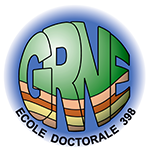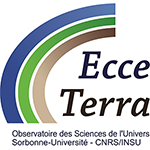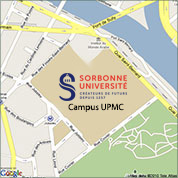Séminaire ISTeP - Matilde Ferrante

(IPGP)
Deep-sea sediments porosity over the last 74 Ma in the equatorial Atlantic Ocean: Implications for paleoclimate
Deep-sea sediments record the geological and climate history of the Earth. The seismic properties of these sediments, namely the P- and S-wave velocities, depend on their chemical compositions and grain size which, in turn, influence porosity. Here, we first use multichannel seismic reflection data to estimate the sediment thickness continuously covering 0-27 Ma old crust of the South American Plate and 0-74 Ma old crust of the African Plate in the equatorial Atlantic Region. We then integrate P-to-S converted waves from the basement-sediment interface recorded by 69 multi-component ocean bottom seismometers. This step allows the estimation of the ratio of P- and S-wave velocities (VP/VS) spanning the above age range. We find that the VP/VS increases nearly linearly from ~6 at 5 Ma to ~20 at 37 Ma, and then gradually decreases to ~7 at 74 Ma. These variations are symmetric across the Mid-Atlantic Ridge, at least in the 0-27 Ma range, suggesting that they are due to climate change rather than regional effects. Furthermore, we estimate the sediment porosity by combining the results with the porosity information derived from nearby ocean drilling program boreholes. We find that the average porosity decreases from 85% at 37 Ma to 70% at 74 Ma, possibly associated with compaction and the presence of marginal sediments. The porosity is rather high (>85%) between 19 Ma and 37 Ma; it shows a sharp decrease to <70 %, at 23 Ma and 17 Ma, and then slightly increases to 72 % at 2 Ma. The decrease in the VP/VS values from 37 to 19 Ma seems to be correlated with the decrease in the global atmospheric CO2 from 800 ppm to 400 ppm, suggesting a climate effect. The climate change at 34 Ma from a greenhouse to an icehouse world correlates well with the change in porosity at this age, possibly related to the fauna/flora diversification and to the calcareous sediment accumulation. The variation in porosity at 23 and 17 Ma also appears to be linked with other major climate shifts, suggesting that sediment porosity could be used to shed light on the past climate and fauna/flora characterisation.
Ce séminaire/webinaire se tiendra en présentiel dans la salle de conférence de l'UFR TEB (46-56, N2) ainsi qu'en ligne à partir de 12h30 via le lien Zoom ci-dessous.
https://us02web.zoom.us/j/81850809242?pwd=MG8yTzZGUTlWU1FzRm9oVU14cUY5Zz09
ID de réunion : 818 5080 9242
Code secret : PuQ11T
Egalement dans la rubrique
- Séminaire ISTeP - Aurélien Beaumais
- Séminaire ISTeP - Céline Baudouin
- Séminaire ISTeP - Stephen Centrella
- Séminaire ISTeP - Bruno Scalabrino
- Séminaire ISTeP - Guillaume Bonnet
- Séminaire ISTeP - Gaétan Milesi
- Séminaire ISTeP - Olivier Galland
- Séminaire ISTeP - Julien Charreau
- Séminaire ISTeP - Marine Paquet
- Séminaire ISTeP - Fabio Speranza
- Séminaire ISTeP - Philippe Yamato
- Séminaire ISTeP - Manon Delaison
- Séminaire ISTeP - Frauke Klingelhoefer
- Séminaire ISTeP - Geoffroy Mohn
- Séminaire ISTeP - Leïla Ben Khelifa
Chiffres clés
L'ISTeP comprend 108 membres dont :
- 12 professeurs
- 21 maîtres de conférences
- 2 directeurs de recherche CNRS
- 2 chargés de recherche CNRS
- 7 ATER et post-docs
- 26 doctorants
- 21 ITA-IATSS
- 17 collaborateurs bénévoles / émérites





